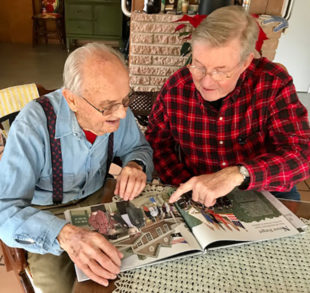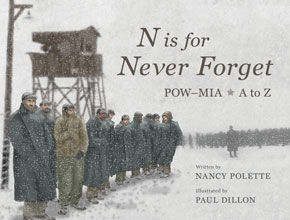A formation of military aircraft provides close air support for illustrator Paul Dillon as he works in the studio of his Missouri home. More than a dozen model airplanes—including two B-17s in honor of his father—are suspended from the ceiling, a silent squadron of inspiration for the artist.
Military history inspires Paul’s work both on and off the drawing board. He is president of the Jefferson Barracks POW-MIA Museum near St. Louis, Missouri, and illustrator of N is for Never Forget: POW-MIA A to Z, a picture book for middle-grade readers by Nancy Polette (Elva Resa 2017).
Some chapters of history are especially personal for Paul. During WWII, his father, Richmond Dillon, was a ball turret gunner on the crew of a B-17 Flying Fortress. After his plane was shot down over Germany in 1943, Richmond was a prisoner of war for twenty months. Like many who survive the hardships of war, Paul’s dad didn’t tell his stories often. Here in Paul’s studio, his dad’s stories are everywhere.
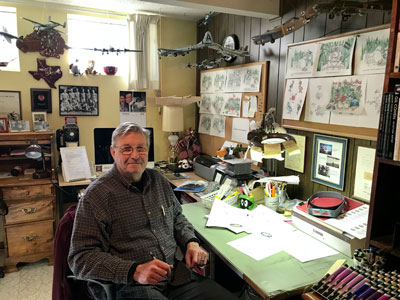 In fact, the studio is as expressive as Paul’s artwork, revealing much about his own interests and history: model ships, as well as airplanes, cartoons, drawings, works finished and in progress. Furniture made by his father. A clock shaped like Texas, his birthplace; another in the unmistakable outline of a Razorback from the University of Arkansas, his alma mater. Both clocks were gifts from his father.
In fact, the studio is as expressive as Paul’s artwork, revealing much about his own interests and history: model ships, as well as airplanes, cartoons, drawings, works finished and in progress. Furniture made by his father. A clock shaped like Texas, his birthplace; another in the unmistakable outline of a Razorback from the University of Arkansas, his alma mater. Both clocks were gifts from his father.
Paul also has a working payphone.
“I got it after I returned home from the Army. I spent so much time on the pay phone when I was in the service that it just seemed the natural way to make a phone call.” Paul jokes, “I have taken clutter to the next level. My wife has placed an ‘Enter at Your Own Risk’ warning at the top of the stairs.”
Belying his words and befitting his museum connections, Paul’s collection is carefully curated, and he admits every item has a story. Framed art and photos, large and small, cover much of the wall space. One frame holds a rubbing of his cousin Dickie’s name from the Vietnam Veteran’s Memorial, another holds a photo of his dad taken in the POW camp just before it was liberated. There’s a photo of his father—who played semi-pro baseball in his younger days—throwing the ceremonial first pitch at a St. Louis Cardinal’s game.
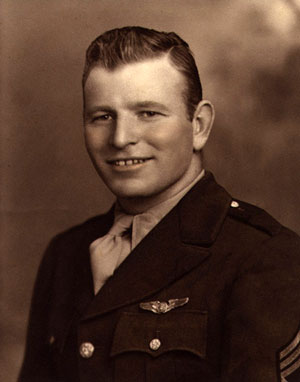
Paul’s dad, Richmond Dillon, was a World War II B-17 ball turret gunner. Shot down in 1943, Richmond was a POW for twenty months in Stalag 17B.
Above the computer where Paul created the digital paintings for N is for Never Forget hangs a photo of the crew, including his father, of a B-17 dubbed “Superstitious Aloysius.” Another, Paul points out, is Eldon Broman.
“Eldon was the pilot of ‘Fritz Blitz,’ the B-17 that dad was shot down on.”
“While growing up … I gradually came to know that Dad had been shot down and was a prisoner of war, but that was about it,” says Paul. “It was only after I was grown … and had been in the service myself, and he was in his later years, that I began to actually learn dad’s story.”
Discovering and preserving personal wartime stories like his dad’s has become a passion of Paul’s. He fears these individual pieces of history are in danger of being forgotten, and he hopes to change that, through his artwork in N is for Never Forget and his work at the museum.
Paul’s involvement in the founding of the Jefferson Barracks POW-MIA Museum also came through a connection with his father. As a next-of-kin member of the American Ex-Prisoners of War Organization, Paul was the commander of the organization when a Missouri congressman invited veterans groups in the state to participate in establishing a POW-MIA museum in the Jefferson Barracks Historic District. Paul has been an advocate for the project ever since. He and the rest of the museum board continue to seek stories, artifacts, and funding to renovate the building, which formerly served as officers’ quarters.
“It was built in 1896, so we are dealing with all the little quirks and surprises of a 122-year-old historical building. We hope to have the first floor ready for a soft re-opening on September 21, National POW-MIA Recognition Day.”
To keep POW-MIA history accessible during construction, the museum displays stories and photos on both its website and Facebook page. The stories in N is for Never Forget have reached beyond the walls of the museum, both in the US and overseas, while proceeds from book sales contribute to refurbishing what is inside those walls.
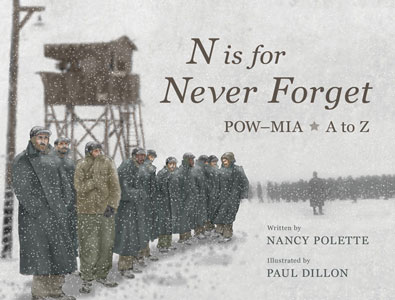 In many ways, Paul’s work with the POW-MIA museum goes hand-in-hand with his work on the book. He is often in contact with former POWs and their families, and families of those missing in action, helping them preserve and tell the stories of their loved ones, stories that reveal humanity as well as history.
In many ways, Paul’s work with the POW-MIA museum goes hand-in-hand with his work on the book. He is often in contact with former POWs and their families, and families of those missing in action, helping them preserve and tell the stories of their loved ones, stories that reveal humanity as well as history.
“These stories … serve as proof that there’s something deep down inside us all if we can only find it, that allows us to face adversity day in and day out, no matter how cruel or ruthless it is,” says Paul. “It’s not always with weapons or force that the battle is won. Sometimes it’s simply a matter of enduring.”
Desire to honor the endurance and service of veterans like his father fuels Paul’s determination to collect and preserve their stories, but the spark for N is for Never Forget came from an experience with a child. While accompanying a traveling exhibit from the museum, Paul overheard a young girl talking to a docent. Seeing the black and white POW-MIA flag on display, the girl asked, “What’s a pow-meeah?”
Her question made Paul wonder how many more young people might be unaware of the meaning of those acronyms and the service and sacrifice they represent.
“The idea of a child-friendly book explaining the POW-MIA experience popped into my head,” he says, “and I immediately thought of Nancy Polette. I knew if anyone could make such a book interesting and accessible for younger readers, it would be Nancy.”
The two began working together to choose the stories and create the artwork to illustrate them. Nancy’s narrative begins with A for Artist, a prisoner of war whose “artwork reflects the hardships of prison life.” In N is for Never Forget, Paul’s artwork continues those depictions.
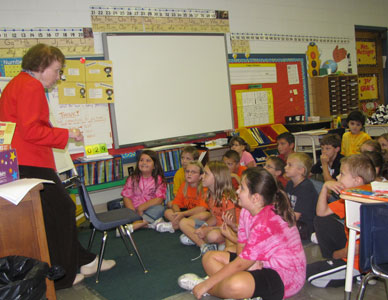
A retired teacher, Nancy Polette, author of N is for Never Forget: POW-MIA A to Z, has written more than 170 books for youth.
A teacher and professor of education, Nancy has written many books for young readers. In addition to N is for Never Forget, she has written historic stories about wartime spies and military nurses, including the award-winning middle grade nonfiction book The Spy With the Wooden Leg: The Story of Virginia Hall.
She says history can be difficult for children to grasp, because their own histories are relatively brief, and history textbooks too often focus on facts and dates instead of people and their adventures.
“History is people,” says Nancy. “Learning the stories of real people, regardless of the time in which they lived is far more effective in giving children an appreciation and understanding of past times, places, and events.”
Paul—relying on historical drawings, photographs, and firsthand descriptions—created digital paintings for each letter of the alphabet in the A to Z book. He drew on his own collection as well. His cousin Dickie’s name appears on the Vietnam Wall illustration on the V page.
Since the publication of N is for Never Forget on Pearl Harbor Day, 2017, Paul has had numerous opportunities to present copies of the book to former POWs or their families and to the families of those missing in action.
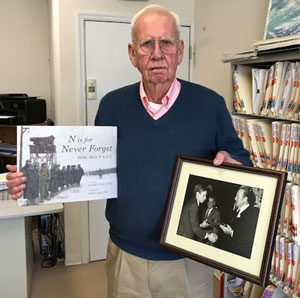
Skip Schumacher holds his copy of N is for Never Forget and a photo of himself receiving an award from actor John Wayne. Skip was on the USS Pueblo when it was seized by the North Koreans in 1968 and he was held prisoner for 11 months.
He gave a copy to Skip Schumacher soon after its publication in December, just two days before the 49th anniversary of Skip’s liberation as a POW. Skip was the operations officer aboard the USS Pueblo on January 23, 1968, when the ship was seized in international waters by North Korean naval forces. One crewmember died. Skip and the rest of the crew were held prisoners of war for eleven months and released on December 23, 1968.
While fighting in the US Army in France, Bill Koeln (feature photo) was captured by German forces in December 1944. Paul gave Bill a copy of N is for Never Forget seventy-three years after Bill’s capture. Paul pointed out to Bill that a drawing of him appears in the book and also on the special edition commemorative dust jacket.
Responses from former POWs when they receive a copy of the book are more emotional than verbal, says Paul, and profoundly moving.
“It’s a feeling I can’t describe. What I remember the most is the look in their eyes and on their faces, saying everything that needed to be said,” says Paul. “When we’re able to give the book to a POW or a family, it’s like giving the book to the person who gave us the stories.”
Paul is thankful he was able to present a copy to Skip, who died a few months later.
N is for Never Forget includes stories or pictures of POWs from many eras, including David Eberly, an Air Force pilot who was shot down and imprisoned during the Persian Gulf War, and Shoshona Johnson, a soldier captured in the Iraq War, also the first African-American woman held as a POW.
Reading the book is moving to those whose stories it tells. For those who have not heard the stories, the book introduces meaningful pieces of history. Both audiences are important to Paul.
“I hope readers come away knowing that our history is really an amazing compilation of smaller stories about the heroism, courage, service, and sacrifice of a large group of diverse individuals,” Paul says, surrounded in his studio by reminders of such stories, each one significant to him and—in its own way—to history.
“It’s up to the storytellers of each generation to make sure that they are discovered, and told and retold in such a way that they will not be forgotten.”
Paul Dillon
Web: ElvaResa.com/author-illustrator/Paul-Dillon
Jefferson Barracks POW-MIA Museum
Web: JBPOW-MIA.org
Facebook: /POW.MIA.Museum
N is for Never Forget books
Special edition with keepsake jackets available from MilitaryFamilyBooks.com and the Jefferson Barracks POW-MIA Museum. Regular hardcover edition available from Amazon.com and other booksellers.
Feature photo: Bill Koeln was captured while fighting in the US Army in France in 1944. Here, Paul Dillon points out Bill’s picture in one of Paul’s illustrations for N is for Never Forget. Photo courtesy Paul Dillon.
Inset photos courtesy of Paul Dillon and Nancy Polette.
Terri Barnes is a regular contributor to Books Make a Difference magazine, author of the book Spouse Calls: Messages From a Military Life, and senior editor at Elva Resa Publishing (a publisher specializing in books for and about military families). Terri’s husband is a retired Air Force chaplain.
This article was first published July 2018.

